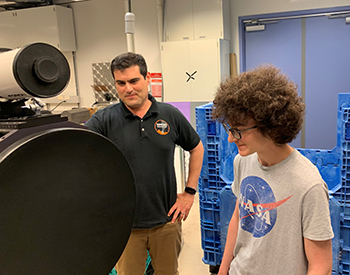A Rocket Man in His Own Right
UC San Diego cosmology expert Brian Keating includes next-generation scientists in his orbit
June 3, 2019 | By Cynthia Dillon
 Brian Keating (left) shows Isaac Broudy a telescope in the lab at CASS. Photo courtesy of Brian Keating
Brian Keating (left) shows Isaac Broudy a telescope in the lab at CASS. Photo courtesy of Brian Keating
Professor of Physics Brian Keating arguably has had an amazing year. His book, “Losing the Nobel Prize: A Story of Cosmology, Ambition, and the Perils of Science's Highest Honor,” was recognized as one of the best science books of 2018 by Amazon, Forbes Magazine and Science Friday. He also received an Excellence in Stewardship Award from UC San Diego, and he was recently named an honorary member of the National Society of Black Physicists. On top of that, he recently received the Chancellor’s Distinguished Professorship in Physics. According to Keating, however, his greatest academic satisfaction comes from working with students—including high schoolers.
“I became infatuated with astronomy, specifically, and science, generally, in high school,” explained Keating in discussing his motivation to inspire pre-college-aged students. “I have a slightly selfish reason as well: if I can ‘hook’ these kids on science in high school, I have a great chance at encouraging them to attend UC San Diego, too. It’s especially important to reach young people at this crucial age to avoid them leaving STEM before they have their chance to shine.”
Keating works with girls and boys in grades nine through twelve who attend public and private schools from Chula Vista to Escondido. For example, students like Isaac Broudy and Yash Melkani, who participate in laboratory activities right along with undergraduate and graduate students at UC San Diego.
 Bonita High School student Isaac Broudy (right) examines a telescope as Brian Keating looks on. Photo courtesy of Brian Keating
Bonita High School student Isaac Broudy (right) examines a telescope as Brian Keating looks on. Photo courtesy of Brian Keating
“They get to see what it’s like to be a student at the next level, and the level after that,” noted Keating.
According to Keating, the high school students work on computer programming and data analysis. They also observe with telescopes around San Diego County, including Mt. Laguna, which, according to the professor, is “really special.”
Keating noted that many of the younger students he mentors have presented at their high school science fairs. Broudy, for example, even went on to win the San Diego County Science Fair, twice, and later placed fourth at the California State Science Fair. He also recently gave a TEDx Talk about learning and teaching science inside and outside the classroom.
“The skills that I have acquired through my time in the Keating lab have led to my successes and have grown me into a scientific thinker. I am grateful to be able to work with Dr. Keating and hope to continue exploring the universe with him,” said Broudy.
Students like Broudy and Melkani, come to Keating’s attention when parents seek him out after public lectures, or when UC San Diego faculty and staff members ask him to mentor their kids. Keating said that his only prerequisites are that the students demonstrate extreme curiosity and passion, and he prefers to know they’ve watched popular science videos on YouTube.
Once part of the research team, the students work in Keating’s lab at the Center for Astrophysics and Space Sciences (CASS) in the Science and Engineering Research Facility (SERF), located near the Price Center in the middle of campus.
“As a high school student, what's cool about working in a lab is the experience it gives you. It really does prepare you for what's to come, which I think is valuable at this age,” said Melkani. “You also get to do more engaging and advanced things like constructing telescope equipment and developing automation software. Overall it's a unique experience, and I am glad of the kind of exposure I am receiving in Dr. Keating’s lab.”
Brian Keating is a professor in the Department of Physics at UC San Diego. He is a public speaker, author, inventor and an expert in the study of the universe’s oldest light, the cosmic microwave background (CMB). Keating co-leads two international experiments: one is called POLARBEAR 2 and the other is an expansion of the POLARBEAR project now underway called the Simons Array. Both are situated in northern Chile.

